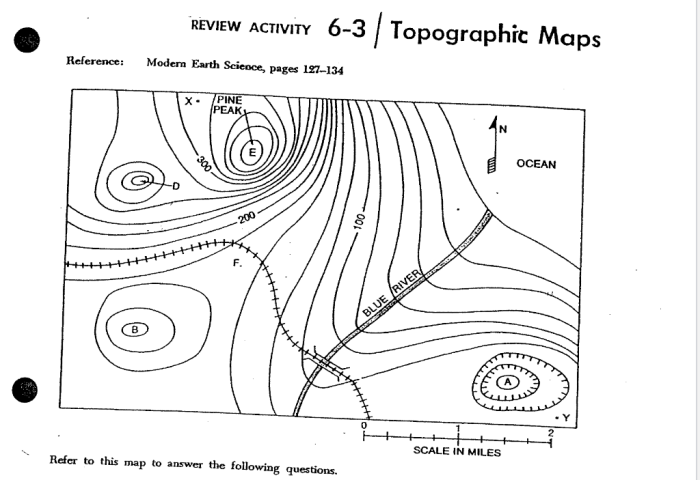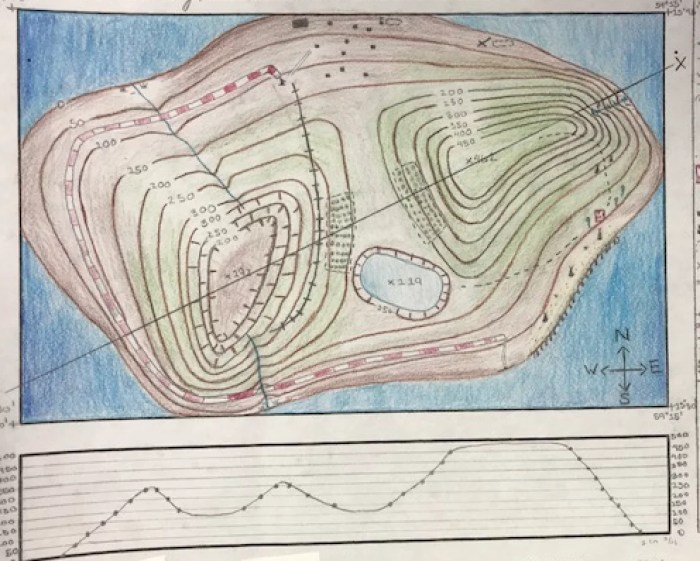Embark on an educational journey with our comprehensive Earth Science Topographic Map Worksheet, a valuable resource designed to illuminate the complexities of terrain analysis. Through a captivating exploration of key concepts and practical applications, this worksheet empowers you to decipher the intricate language of topographic maps, unlocking a wealth of insights into the Earth’s surface.
Delving into the fundamentals, we unravel the purpose and diverse uses of topographic maps in earth science. We meticulously dissect their essential features, including contour lines, elevation, and scale, providing a solid foundation for comprehending the topography of any region.
Topographic Map Basics: Earth Science Topographic Map Worksheet

Topographic maps are a fundamental tool in earth science for visualizing and analyzing the Earth’s surface. They depict the elevation and shape of the land, providing valuable information about terrain, landforms, and geological features.Key features of topographic maps include contour lines, which represent elevation, and scale, which indicates the ratio between map distances and actual ground distances.
By understanding these features, topographic maps can be used to determine the elevation of points, calculate slope and gradient, and analyze landforms.
Contour Lines
Contour lines are the backbone of topographic maps, representing lines of equal elevation. They connect points of the same height above a reference datum, typically sea level. Different types of contour lines include index contours, which are thicker and labeled with their elevation, and intermediate contours, which provide additional detail.By
interpreting contour lines, we can determine the slope and shape of the land. Closely spaced contour lines indicate steep slopes, while widely spaced contour lines indicate gentle slopes. The direction of the slope can be determined by the direction in which the contour lines descend.
Relief and Elevation, Earth science topographic map worksheet
Relief refers to the difference in elevation between the highest and lowest points in an area. Elevation, on the other hand, is the height of a point above a reference datum. To determine the elevation of a point using contour lines, simply identify the contour line that passes through the point and read its elevation value.Calculating
the relief of an area involves finding the difference in elevation between the highest and lowest points within the area. Topographic maps provide a convenient way to determine these values.
Slope and Gradient
Slope refers to the steepness of a land surface, while gradient is the numerical measure of slope expressed as a ratio of vertical rise to horizontal distance. To calculate the slope and gradient of a slope using contour lines, measure the vertical distance between two contour lines and the horizontal distance between them.
The gradient can then be calculated by dividing the vertical distance by the horizontal distance.Slope and gradient analysis is crucial for understanding landforms and potential hazards. Steep slopes can indicate areas prone to erosion or landslides, while gentle slopes may be suitable for development or agriculture.
Map Analysis and Interpretation
Analyzing and interpreting topographic maps involves extracting information about the terrain by identifying landforms, drainage patterns, and geological features. Landforms, such as mountains, valleys, and plateaus, can be identified by their characteristic contour patterns. Drainage patterns, such as rivers and streams, can be identified by the direction of contour lines and the presence of V-shaped valleys.
Geological features, such as faults and folds, can be identified by their distinct contour patterns.Scale and contour interval play a crucial role in map analysis. Scale determines the level of detail on the map, while contour interval determines the spacing between contour lines.
A smaller contour interval provides more detailed information about the terrain.
Frequently Asked Questions
What is the purpose of a topographic map?
Topographic maps provide a detailed representation of the Earth’s surface, depicting the elevation, slope, and other physical features of a particular area.
How do contour lines represent elevation?
Contour lines connect points of equal elevation on a topographic map, forming a series of concentric lines that depict the shape and slope of the terrain.
What is the difference between relief and elevation?
Relief refers to the vertical difference between the highest and lowest points in an area, while elevation indicates the height of a specific point above a reference level, typically sea level.
